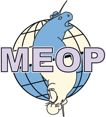
Over 800,000 vertical profiles of Temperature and Salinity have been collected since 2004 in the World Ocean by attaching tags on marine mammals, such as Southern elephant seals.
In this website, you will find information about the marine mammal tagging programs, and an access point to the publicly available databases.
Please let us know if you are using our data. You can contact us by mail to info@meop.net if you have any question.
The MEOP data portal
Content of the website
Video presentation on Youtube
Video of introduction of MEOP and of the GOOS network Animal Borne Ocean Sensor, Clive McMahon and Fabien Roquet, August 2021 (starts at 3:16):
Equipping marine animals with biological and physical sensors is a long-established approach for studying their behaviour, their ecology and their environment, and has been producing rich data streams for several decades. A new GOOS network, the Animal Borne Ocean Sensors (AniBOS), aims to coordinate the collection and deliver of marine data into the broader observing network. AniBOS provides a cost-effective capability to the Global Ocean Observing System (GOOS) to monitor essential ocean variables (EOV) and essential biodiversity variables (EBV) in data poor areas, by providing inputs to estimates of global ocean indicators and quantifying seasonal and interannual variability of the upper ocean state. AniBOS augments considerably observations of temperature and salinity (TS) in the upper ocean provided by other platforms. These are urgently needed for an improved understanding of climate variability and ocean variability. These hydrographic observations also provide a wealth of data on animal movements and behaviour that directly link environmental state and animal performance. This knowledge is essential to develop evidence-based policy protect the animals and their habitats from increasing human activities through improved understanding of their biology and spatial ecology and is a key objective of the GOOS EBVs. Formal recognition of the animal borne ocean sensors network within OCG GOOS improves our ability to observe and understand the oceans and the animals that live in them, thereby improving our understanding of global ocean and climate processes for societal benefit.

